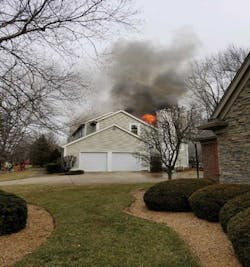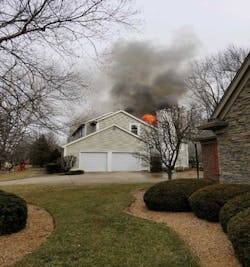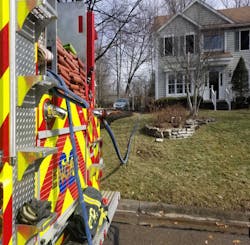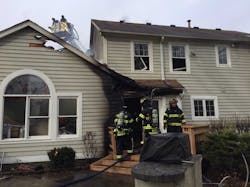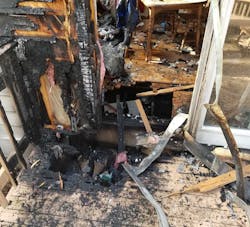Close Calls: Fireball Blows Over Heads of Exiting Crews
Like most of you, if my department is due on a fire, I want to be a part of that response. I have felt that way since 1973, and nothing has ever changed for me. As I do spend a significant amount of time on the road, I am bound to miss some jobs from time to time. This complex call was unfortunately one of those times.
“Expected outcomes”
Loveland-Symmes Fire Department (LSFD) Chief Otto J. Huber and I have had many discussions about this issue of “expected outcomes.” One of the rewards of a tough, tenacious and driven mission, focus and leadership is knowing how your department will operate, regardless of whether you are in town. More specifically, I’m talking about department standards, expectations, policies and procedures. I’m talking about no-nonsense company and command officer expectations and the critical need for discipline on the fireground. This includes discipline where it is clear, through standard operating procedures/guidelines (SOP/SOG)-driven expectations and related training, what will be done, by who and how at “that” fire, as well as expectations that require training and leadership to create an environment where the fireground is not deemed a personal playground.
While all fires may have different conditions, certain tasks must always be accomplished, and that concept is based upon community risk assessment. In simple terms, fire departments that evaluate what they protect, how much they protect, along with scientific and historical data, can then take that info and apply it to specific expectations on the fireground.
I brought this up specifically for this Close Call because our department—and our mutual aid partners—have all worked very hard in creating a regionally disciplined fireground that operates based upon standards applied to predictable and found conditions. I think this Close Call exemplifies the coordinated nature of the department’s response to a complex incident that could have gone terribly wrong had it not been for the alertness of command officers keeping an eye on fire conditions.Initial response
On Jan. 31, 2018, at 9:57 a.m., LSFD was dispatched by Northeast Communications to a structure in the City of Loveland. The first unit on scene arrived at 10:01 a.m., and found a medium, two-story residential structure with a working fire.
The first alarm assignment consisted of:
· LSFD: Engine 63, Quint 63, Quint 62, Tower Ladder 61, Engine 60, Battalion 62 shift commander, staff chiefs, Emergency Service Unit, and Incident Management Assistance Team (IMAT), which consists of area mutual-aid chiefs
· Deerfield Township Fire-Rescue (DTFR): Rescue 57 and Battalion 57
· City of Blue Ash: Engine 13
· Sharonville: Quint 88
Once a working incident was transmitted, Goshen Township Engine 18 and Chief 18 provided area coverage.
For this month’s Close Calls column, we’ll review several individual accounts of the incident, underscoring the differing perspectives. Next month we’ll review lessons learned from the incident.
Account from LSFD Captain Bruce Hawk
I was the Battalion 62 shift supervisor and incident commander (IC) on the incident. During our morning conference call, we discussed weather conditions and identified the potential for high winds (up to 30-mph gusts), emphasizing the need to be prepared if we had a fire.
We were initially dispatched to the area of Quailwoods Drive for a report of a structure fire behind that residence. I responded to the area and reported a fire in a block behind the structure—and I proceeded there.
My radio report was as follows: “Battalion 62 to Northeast (our dispatch center), 124 Pheasantlake Dr. We have a medium, two-story residential structure with a working fire on the Charlie side. Command and accountability is established on Alpha side and we’ll operate in the offensive strategy.”
Following my initial report, Chief 6001 (Huber) arrived on scene and completed a 360 of the residence, which revealed the working fire in the basement, the rear deck and extending up the side of the dwelling. The first-arriving engine, Engine 63, was assigned to deploy an extended attack line to the Charlie side for fire control.
Chief 6005 (Mike Books) arrived on scene and reported to the Charlie side to establish Charlie division. Chief 6001 assumed Alpha and assigned the second-due apparatus to extend a secondary attack line to the Charlie/Delta corner. Charlie division identified that the floor joists had been burned out on the first floor, directly inside the Charlie side patio door. Charlie division then reported that the fire on the exterior of the structure was knocked down, and water was being applied to the basement from the exterior through the hole in the floor. Additional companies arrived on scene and were assigned to Alpha.
I was able to confirm via a family member that that residence was unoccupied, as the residents were out of town.
The secondary attack line was redeployed to the Alpha side, and crews were assigned to the second-floor interior to check for extension into the attic space. Alpha assigned the Tower 61 crew to investigate the first floor, and the crew identified the basement stairs and confirmed that the stairs were intact. However, during this process, conditions were worsening, as we suspected we had extension from the fire, which started in the basement, vented to the rear deck, and spread up the sides to the roof/attic area.
The high wind conditions contributed to deteriorating fire conditions to the attic space and eaves, which resulted in rapid fire advancement to void spaces in the Charlie/Delta corner. Companies working on the second floor reported moderate heat and heavy smoke conditions, and were unable to initially locate where the fire had advanced. These factors led Huber to request a change in strategy.
I advised all crews on the fireground that we were transitioning to defensive operations. I had already assigned a crew to secure a secondary water supply and begin preparation for aerial operations on the Alpha side.
As crews from Tower 61 and Rescue 57 were pulling out of the building, they were followed by a ball of fire. Fortunately, no one was injured, as they were just far enough removed from the structure at the time of the fireball.
Quint 62—Firefighters Eric Webb and Craig Van Fleet—and Tower 61 were positioned on the Alpha side to use both aerials for defensive operations. Tower 61 was able to conduct fire attack operations from an elevated master stream that knocked down the bulk of the fire on the Charlie/Delta corner that had vented through the roof. The coordinated fire attack between aerial operations and companies on the Charlie side was successful in significantly reducing the smoke and fire conditions in the structure.
The improved conditions allowed for Alpha division to assign a company to the second floor to check for any further extension into the main attic space. Crews on the second floor reported significantly improved conditions and were able to extinguish hot spots.
Account from Chief Huber, Alpha division supervisor
I notified command that it appeared to be a basement fire from the Charlie side. Upon getting a view of the smoked basement windows on the Bravo side, I asked Engine 63 Captain Matt Stelle to use his TIC on the windows so we could get a better read on the basement. I gave command my report, and communicated that I was moving to the Charlie side, as that was where we were attempting to get a line in service. Once I was relieved by Chief Mike Books taking Charlie division, I returned to the Alpha side and assumed Alpha division. Charlie division got a knock on the fire from their location, and we decided to send a crew to Division 2 for search/rescue and fire control. We had fire increasing in the attic, and our strategy was to get a line into the attic on Division 2. At the same time, we sent a the crew from Tower 61 to the basement to recon the extent of involvement, as our reports from Charlie stated that the TIC was only indicating about 5 feet into the building in the area in which they had extinguished from the Charlie side. The basement crew advised that the steps were intact and they were making a push to the room of origin, while Division 2 reported moderate heat and smoke and that they needed another crew, hooks and hoseline. We deployed another crew to back up Division 2. During this time, Chief Books (Charlie), LSFD Deputy Chief Josh Blum (Safety) and myself conversed numerous times face to face, and confirmed what each of us was seeing and how we independently read the building and smoke. At this point, the wind had increased and seemed to be changing direction, gusting to 30 mph. We could see from the smoke conditions that we had attic involvement and communicated with Division 2 to reinforce our need to get a line in the attic. At this point, Charlie division reported that we had collapse of the cathedral ceiling-type roofing on the Charlie side.
From what we were seeing on the Alpha side with the uncontrollable wind gusts and the report I received from Division 2, I informed command of my decision to switch strategies. As the last crew exited the structure, a fireball blew out of the Alpha doorway over their heads as the smoke lit off.
Account from LSFD Captain Matt Stelle, Engine 63 officer
On the day of the fire, our staffing included Firefighters Matt Mize (pump operator), Tyler Mirick, Hunter Peron and myself—four staff for the day, which was normal for us.
As the captain on the first-due engine, I identified numerous hydrants on the block using our Active911 System technology, and at that time Battalion 62 (Hawk) advised of the working fire. I told my driver to pull past the house on the Alpha/Bravo corner, as I knew that based on the size of the house, I would be choosing 400 feet of 1¾-inch dead load line, and I wanted to leave room for the truck companies.
We stretched along the Bravo side of the house, but the stretch had to be stopped initially because of an older wooden fence. We were able to quickly overcome that obstruction and continue the stretch to the Charlie side. While we were momentarily stopped, I was able to look into the two basement windows. It was obvious that the basement was very smoky, but the windows had no sign of heat damage.
The attack line was stretched to the middle of the house on the Charlie side where the main body of fire was located. The engineer broke the line at 300 feet, giving us plenty of extra to make a push inside the house if needed.
A quick attack was made to the exterior of the house to knock down the fire, which was auto-extending up the side of the home due to failure of the sliding glass door on the patio. We were successful at doing that with only 15 seconds of water application. We had the knowledge of this being a basement fire based on the information received upon completion of the 360 report.During this time, the Charlie division chief and I saw that the porch was burnt away at the home. There was visible fire that was coming out of a 3 x 3-foot hole in the floor just inside the sliding glass door entering in to the kitchen. We were able to place the hose stream into the hole in the floor and extinguish a significant amount of active fire.
I took a brief moment to use my thermal-imaging camera (TIC) to scan inside the home. I saw the entire kitchen area, the hardwood floor and floor joist along with the exact location and size of the hole in the floor. While scanning with the TIC outside, I was also able to see a clear thermal difference on the foundation. That finding reinforced the location or origin of the fire in the basement.
The wind conditions were changing throughout the initial 5–10 minutes. By this point, we were focusing on the changing smoke conditions that were evident at the roof line. There were already companies interior on the second floor for fire attack. Just to the left of the patio, going toward the Charlie/Delta corner, were three large windows for the large living room. It was very smoky with fire conditions present. Looking into one of the windows, you could see fire coming and lighting off the smoke that was in the space—the same effect you would see looking inside of a wood fire stove. I made the decision to take out that window (Charlie division) and apply water to that space, as I knew there were no interior companies operating anywhere near that location. We would apply high gpms to that space and have an effect on the fire, but within 10–15 seconds, fire conditions would start again. I looked through the window standing on the ground level outside and was able to see a 2 x 2-foot burn-through hole in the floor just off the wall.
By this time, the fire had traveled well through the walls into the void space above the tall vaulted ceiling in the living room space. The fire had breached the roof decking on the Delta side of the house and was rapidly growing with the wind conditions.
With the multiple command officers positioned around the building, I believe that they were able to prepare for this event before it happened. Tower 61 and Quint 62 were both in good positions and were able to react to the change in strategy. During the strategic shift, my crew quickly recycled and went on deck on the Alpha side. (“On deck” is the next up company, which may also be deployed as rapid-assistance team, or RAT.)
Account by LSFD Captain Bill Adkins, Tower 61
When Tower 61—myself along with Firefighters Scott Jones, Thomas Viars, Kyle O'Keefe and Sam Keegan—arrived, there was moderate smoke coming from the entire roof. The smoke was a brownish color and was obviously wind driven from the Delta side moving toward the Bravo side. Our first assignment was to go on deck side Alpha.
The Tower 61 crew came off the apparatus with Halligan bars, flathead axes, two New York hooks, a RAT pack and a wide-area search bag, and each crewmember had a radio, light and TIC.
We were directed by the Chief 6001 (Alpha division) to force the front door. I started to force the door using the baseball swing method. The door was secured by a padlock and door handle lock. The front door was somewhat difficult to force due to what appeared to be a long bolt on the locking system. After a couple of tries, the front door was forced. Rescue 57 was then assigned to the second floor, and we were assigned to the basement with DTFR’s Battalion Chief Dan James.
Tower 61 pulled a 1¾-inch attack line with a vindicator nozzle into the basement. Smoke conditions were moderate brown smoke. Smoke was fast moving from the wind conditions. We encountered a door to the basement that opened toward the front door, and we advanced approximately 75 feet past the basement door to be able to advance downstairs. Once we advanced into the kitchen, we encountered flames toward the living room, put water on the fire, and proceeded to the basement.
There was slow-moving white smoke in the basement, and visibility was close to zero. Our crew made a right turn at the bottom of the stairs and proceeded to look for the base of the fire. Shortly thereafter, there was a transmission to evacuate the building for defensive operations.
My first thought was that there was no way the conditions changed so fast so as to go defensive, but of course we did as ordered and exited the structure on the Alpha side. Once I exited the structure, I looked up and noticed heavy fire through the roof—an obvious defensive fire.
Account from DTFR Captain Marc Brinker, Rescue 57
Rescue 57—myself and Firefighters Matt Hannigan and Ken Lynch—along with the Battalion 56 crew were placed on deck but then quickly reassigned to meet up with and assist the Tower 61 crew on the Alpha side interior. We were met by Chief Blum (Safety), who advised that there was a basement fire with a partial first-floor collapse on the Charlie side just inside main door.
As I sized-up, something didn’t match up in my head. We had a basement fire in a modern, Type V, non-balloon, platform frame house with an attic fire as well. This was prior to knowing that the fire had traveled vertical and breached the cockloft in the great room area. It was confirmed that there were two separate areas of concerns—the attic and the basement. Smoke conditions were moderate on the first floor with about 3–4-foot visibility from floor level, no fire noted.
I conducted a face to face with Chief Huber and advised of the findings inside the front door. Meanwhile, the rest of the Rescue 57 crew assisted LSFD companies in stretching a 1¾-inch handline to the front door to prepare for offensive operations.
We were ordered to ascend to the second floor, open the attic area, and attempt an offensive attack. We stretched the 1¾-inch hoseline and made the second floor via the main/front staircase without incident.
Once at the top of the stairs, I reported moderate heat and smoke conditions and decided to make inspection holes in the ceiling to see where the fire was traveling. I noticed no fire in that area of the attic, used a TIC and found nothing that directed us to the seat of fire, but still had moderate heat conditions. Hannigan began to spray the attic area in an attempt to cool the space to prevent any catastrophic ignition of smoke.
I gave a Conditions, Actions, Needs (CAN) report: No change in conditions, actions were that the crew was flanking off toward the Bravo and Charlie side because that is where bulk of the initial fire was (thinking that the exterior fire in the rear auto-exposed into the eaves and into the attic space), and requested additional crews for help with this task. Command confirmed the request.
We continued opening, and conditions began to deteriorate, with smoke increasing to heavy black smoke and high heat pushing down on us. I gathered the crew to advise them that they were going to need to exit soon due to deteriorating conditions. We descended the stairs and exited the building without incident.
Right after we exited the building, a possible smoke explosion/event occurred with such force that it shut the front door.
Part of our crew was assigned to work off the tip of Quint 62 and provide a roof condition report from an elevated position, and we reported a partial roof collapse occurred on the Delta/Alpha side, which appeared to be a separate attic space, and also advised that there was possibly multiple attics spaces.
Tower 61 was successful in extinguishing most of the fire that breached the roof in the Delta/Alpha corner. Once the bulk of the fire was knocked, the other half of the Rescue 57 crew was reassigned interior as we transitioned back to offensive. Because crews went back inside to the second floor, windows on the Alpha side were broken from the tip of Quint 62 for safety and egress.
Account from Deputy Chief Blum, Safety Division
Battalion 62 (Captain Hawk) was first to arrive into the area and did a great job verifying the location and completing an initial and thorough size-up for companies responding. Wind was identified as a potential issue during the morning conference call and then confirmed with units on the scene.
First-arriving Engine 63 positioned just past the house, leaving room for other responding units. Captain Stelle pulled the 400-foot line from the rear of the apparatus. Chief Huber (6001) was working to complete a 360 for command. He confirmed a working fire on the Charlie side from the basement and extending into the roof space.
Captain Stelle utilized the TIC to further size-up the Bravo and Charlie sides to include the basement. The stained glass on the Bravo side indicated a fire in the basement, and the TIC confirmed fire in the basement on the Charlie side through a look-out window that had given way and the floor that had burnt away. A portion of the dining room floor was only being held in tact by the decorative wood floor the floor joists had burnt away. Chief 6001 Alpha assigned DTFR Rescue 57 to go to the second floor to get an all clear and get ahead of the attic fire. Rescue 57 reported heavy smoke with moderate heat and then heavy heat. Conditions on the exterior were rapidly deteriorating, and the Charlie side reported some roof failure with visible fire.
Alpha made the decision based off the CAN reports and visible conditions to change strategy to defensive. Command changed strategy and accounted for all units. Upon Rescue 57 exiting, there was a failure of the drywall, resulting in a burst of turbulent black smoke, and then fire from the front door. The fire quickly went back into the attic space once the gases burned off.
Tower 61 was positioned in a way to get to the roof and get water on the visible fire from what by this time was engulfing one-third of the attic space. Tower 61 quickly knocked down the fire and then units were permitted to go back into the home to the second floor to mop up the hot spots.
Account from DTFR Battalion Chief Dan James
As I walked up to the building, I noted moderate smoke conditions coming from the eaves and gable vents on the Bravo and Delta sides. I met with the Alpha division supervisor, Chief Huber, who advised of the basement fire with extension and partial collapse of the first floor near the back sliding-glass door on the Charlie side with auto-exposure to the number two floor, and possibly attic space on the Charlie/Delta side.
The decision by command was to make this an offensive operation. As I made my way inside the structure, there was still a report of active fire in the basement. I was able to locate the door leading to the basement on the right side of the staircase leading to the second floor. Less than three feet of visibility was noted on the first floor. I opened the door to the basement and was met with heavy smoke conditions. The stair to the basement was still intact and no active fire was noted at the bottom of the steps. I was then met with Tower 61’s crew, and we began to make our way down the steps to the basement to extinguish the fire in the basement.
We had zero visibility with mild heat conditions, and I could hear our team talk on our SpiroComs (internal SCBA communication device) that the conditions on the second floor were changing, and about the same time, I could hear reports (via fireground radio) of fire now showing through the roof on the Charlie/Delta side of the structure. At that time, command ordered everyone out of the structure, and tactics switched to a defensive operation. I was the last one out of the structure and conducted a head count to make sure that everyone was out of the structure.
As we exited, a significant size fire ball came rushing out of the front door, on the Alpha side, slamming the door shut. I proceeded to reopen the front door in a safe position and found fire conditions throughout the second floor. We had Firefighter Hannigan take the hoseline near the front door and start extinguishing the fire on the second floor from the outside of the front door. Chief Huber needed a crew to go up on Quint 62 to pull the soffits to allow excess to the attic space from the exterior of the structure. Captain Brinker and Firefighter Lynch were assigned to complete that task.
Once the bulk of the fire from the roof was extinguished, operations were switched back to offensive operations. Firefighter Hannigan and I, along with LSFD Engine 60 (Captain Dan Walsh, Firefighters Riley Junod and Bob Kirby), entered the structure and attacked the fire on the second floor into the master bedroom on the Bravo side. We were unable to make entry into the bedroom on the Delta side of the structure due to the collapse of the roof in the room.
Account from LSFD Deputy Chief Mike Books (Charlie supervisor)
Upon arrival, I was assigned the Charlie division supervisor, and upon doing so, earlier concerns of wind conditions proved to be valid.
While assisting with stretching hoselines, I heard the floor fall into the basement in the area of the kitchen on the Charlie side. I immediately advised Captain Stelle (Engine 63) and crew to not enter, and I also transmitted the collapse info in the fireground channel.
Water was applied from the Charlie side by 1¾-inch handline from the exterior. The fire was knocked down, and crews were sent in from the Alpha side to find the fire in the basement and check for extension into the second floor. Battalion 61 (Deputy Chief Harold Gregory) joined Chief 6005 on the Charlie side. Smoke conditions continued to get worse from the outside, and crews were reporting moderate smoke and heat conditions interior. Conditions on the outside continued to deteriorate, and a flying standpipe was moved to the Charlie side.
Fire started to break through the siding on the Charlie/Delta corner, smoke conditions deteriorated more rapidly, and the fire then vented through the roof on the Charlie/Delta corner. Shortly after that, a decision was made to move from an offensive strategy to a defensive strategy. Crews were ordered out of the building and accountability was affirmed via PAR check.
During overhaul, it was noted that it appeared that the fire had been burning for some time undetected in the basement due to the charring of the wooden floor joist. Additionally, the room on the Charlie side had a vaulted ceiling, allowing the fire to get into the void space, making it extremely hard to get to and extinguish.
More information ahead
In next month’s column, we’ll review lessons learned from the incident.
Our sincere appreciation to LSFD Chief Huber along with all Loveland-Symmes, Deerfield Township, City of Blue Ash, City of Sharonville, Goshen Township officers and firefighters for their assistance and cooperation in this article.
Sidebar: About the Loveland-Symmes Fire Department
The Loveland-Symmes Fire Department (LSFD) provides fire and ALS EMS transport to just under 30,000 residents in the City of Loveland and Symmes Township in Ohio. Located throughout the city and township are four firehouses, operated by 60 firefighter/paramedics who are assigned to fire apparatus and paramedic ambulances working on one of three rotating shifts.
LSFD protects two interstate highways, numerous commercial, industrial, institutional facilities, and single- and multi-family dwellings, answering approximately 5,000 incidents annually. LSFD full-time personnel are assisted by the LSFD Emergency Service Unit, an active community volunteer-based group of about 18 members handling fire, crash and emergency scene support services along with community events. The regional Northeast Communications Center is located at LSFD Headquarters and handles all fire-EMS communications.
LSFD is an ISO Class 2 department and is accredited by the Commission on Accreditation of Ambulance Services (CAAS) and Center for Public Safety Excellence (CPSE). Every chief officer in LSFD is a graduate of either the Ohio Executive Fire Officer Program or the National Executive Fire Officer Program, and every LSFD officer has attended the National Fire Academy. All officers and firefighters in LSFD are trained and certified as Type 4 and 5 structural and incident fire command officers. LSFD utilizes the Lexipol Fire Policy System for both administrative as well as operational policy.
The Loveland-Symmes Fire Department is led by Chief Huber. He is assisted by Assistant Chief Tom Turner, six deputy chiefs, along with shift commanders and company officers.
LSFD is part of a regional automatic mutual-aid system in which numerous departments (apparatus specific) are alerted to incidents based upon a pre-determined standard of cover, sometimes known as box alarm assignments. Generally, the first-due community will send its resources, and neighboring departments with send specifically assigned equipment and incident management chiefs support. These departments train with one another on a regular basis and all have 100 percent radio interoperability.
About the Author
Billy Goldfeder
BILLY GOLDFEDER, EFO, who is a Firehouse contributing editor, has been a firefighter since 1973 and a chief officer since 1982. He is deputy fire chief of the Loveland-Symmes Fire Department in Ohio, which is an ISO Class 1, CPSE and CAAS-accredited department. Goldfeder has served on numerous NFPA and International Association of Fire Chiefs (IAFC) committees. He is on the board of directors of the IAFC Safety, Health and Survival Section and the National Fallen Firefighters Foundation.
